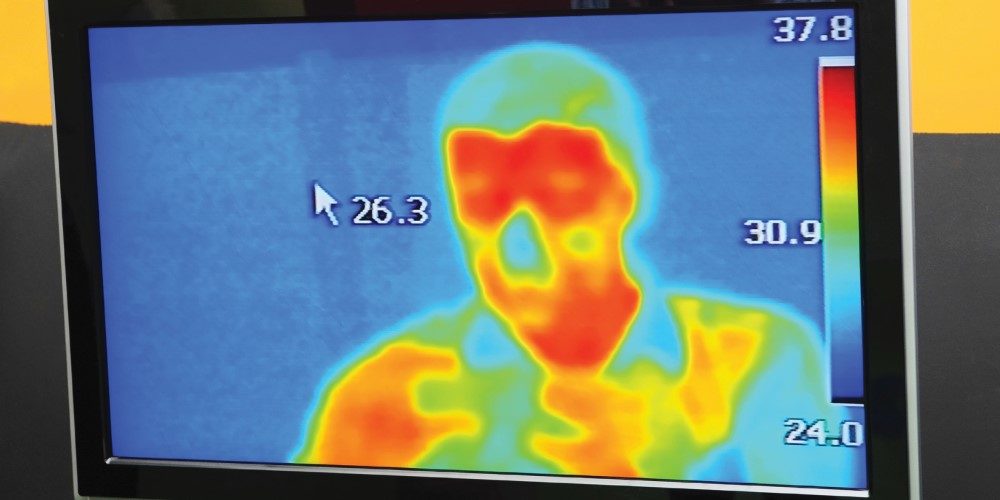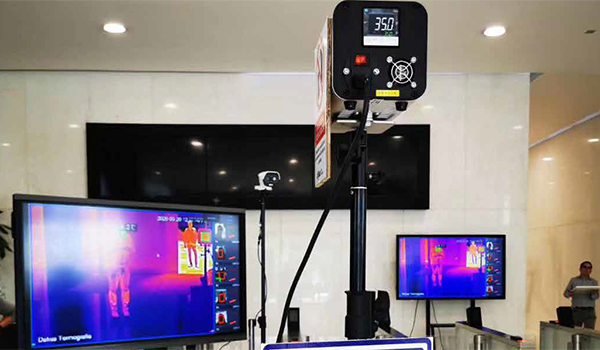As the COVID-19 pandemic stretches on in the United States, innovative solutions have arisen to mitigate the spread of the virus. One that has garnered a lot of attention toward the security industry is the use of thermal cameras to read human skin temperature.
This provides a valuable measurement to determine who may have an elevated temperature. Thermal temperature sensing can help shops and schools reopen, give peace of mind to employers and employees of essential businesses, and serve as an efficient screening tool.
Integrators who want to seize this opportunity to help their customers should understand best practices surrounding thermal temperature measurement technology. In addition, practical considerations must be made to decide whether thermal temperature measurement is indeed the best choice.
How many subjects will you need to monitor and how quickly will you need to take measurements? Are you taking temperatures from members of the public, or just employees? Privacy, or at least unobtrusiveness, may be important; likewise, being able to verify an identity may also be important.
Also consider the physical location of the temperature check station. If it must be installed close to a building entrance, people coming inside will have a skin temperature close to the outside ambient temperature and certain devices may not be ideal.
Do you need to monitor multiple entrances? This will multiply the number of temperature monitoring stations you will need, increasing cost and possibly manpower requirements. Let’s delve into the different solutions.
Temperature Scanning Methods & Best Practices
Traditional temperature evaluation methods involve handheld devices, ranging from oral, ear and rectal thermometers to contact-free methods that use IR or thermal technology to get temporal (forehead) measurements.
Note that human body temperature varies, depending on where it’s measured. Armpit and temporal devices output readings that are 0.5°F to 1.0⁰F lower than oral temperature, while rectal and ear temperature devices are 0.5ºF to 1.0ºF higher than oral temperature.
A more accurate temperature reading can be taken from the medial canthus — the inner corner of the eye. A medial canthus measurement correlates more closely to the internal body temperature than skin measurement. Among thermal camera-based solutions, some measure the medial canthus and some measure the forehead.
If you are on a limited budget, a traditional oral or ear thermometer is the most inexpensive, at least when it comes to the device itself. It will of course require someone to operate the device, which can be costly in terms of labor. It’s a relatively slow method, as well.
It also requires the operator to be physically close to the thermometer, putting them at risk of disease transmission due to close contact with the people they are measuring.
Due to the possibility of cross-contamination, these devices require a thorough cleaning between measurements. Despite these drawbacks, some handheld devices have the highest level of accuracy among all the methods discussed here.
Handheld thermal temperature guns are a reasonably-priced option, at around $150-$300. Though they are contact-free, they do require the operator to be physically close to the subject — fewer than six feet away for sure. They do not require cleaning in between measurements, but the measurement rate is again slow — only one person at a time, with about five seconds needed per person.
Temperature guns are generally less accurate than the thermometers described above, and some models are no more accurate than methods that involve thermal cameras. All contact-free temperature measurement solutions must be deployed indoors because skin temperature is affected by sunlight and ambient temps.
Using Thermal to Measure
Thermal camera-based temperature measurement was developed during the SARS outbreak in 2004. “The use of infrared thermal imaging cameras has been proposed as a noninvasive, speedy, cost effective and fairly accurate means for mass blind screening of potential SARS infected persons,” researcher Eddie Y.K. Ng wrote in a 2005 paper that was published in Medical Physics.
Because thermal cameras can be deployed from several feet away, this solution poses a very low infection risk to the operator. Another benefit of thermal camera solutions is relatively fast screening speed. If a temperature exceeds a user-defined threshold, a live alert is sent via the recorder and/or a mobile app.
Accuracy can be as high as ±0.54°F, but a secondary method of temperature measurement should always be used if an elevated temperature is detected. The secondary device should have better accuracy specs than the primary measurement device.
Thermal systems that employ sophisticated AI can use face detection to make intelligent decisions where best to measure on the face. In other words, the algorithm can home in and take readings only in areas where a face has been determined to be in the field of view.
Hybrid systems combine both thermal and visible light sensors into an integrated package. The thermal sensor provides temperature monitoring and the visible light sensor provides visual identification; both streams are fed into the NVR for synchronized recording and playback.
NVR-based facial identification provides positive ID of known individuals against a user-defined facial database, providing more granular records of individuals during temperature monitoring.
What’s Available
Generally, thermal solutions on the market today fall into one of three categories:
- A handheld thermal gun, which has a small LCD screen (these can usually be mounted on a tripod)
- A monitoring station that consists of a small terminal with an LCD screen and thermal camera
- A thermal camera paired with an NVR/PC, with or without a blackbody device
Each of these has different benefits. A handheld thermal is the least expensive, and usually requires the subject to stand within a few feet for measurement. Temperature monitoring stations have moderate cost, less than $4,000 MSRP per station, and a measurement distance of around six feet.
These are good for low-traffic environments with single entrances, such as small to midsize office buildings, retail shops and restaurants. They are accurate when calibrated to the interior ambient temperature and humidity. If that changes, the user must recalibrate.
Some of these stations have access control capability: a keycard, PIN code or facial ID (if a facial database is used) can be integrated. They can be configured to require multiple credentials before allowing entry. For example: a keycard, plus a detected mask, plus an acceptable temperature reading only allows entry.
A thermal temperature monitoring camera combined with an NVR can be a cost-effective solution that works well in midsize facilities such as schools and department stores. Again, calibration to the interior environment is a must, and temperature variations risk degrading the accuracy of the readings.
A full temperature measurement solution is the most expensive option, averaging around $15,000 to $20,000 per system. It provides a wider angle view and a further measurement distance. Some models offer AI and facial identification features.
The blackbody device, which is deployed within the field of view of the camera and adjacent to the subject, emits a constant temperature to keep the system calibrated even when humidity and ambient temperature changes. This solution can handle greater traffic flow. It’s well-suited for indoor environments at schools, transportation hubs, airports and hospitals.
Temperature Screening Best Practices
In order to achieve the highest level of accuracy, you must ensure the thermal solution is installed and deployed properly. In line with the May 2020 overview from the FDA on thermal imaging systems and COVID-19, what follows are guidelines on how to prepare the area being monitored, the person being evaluated, and the thermal imaging system itself.
Assess the Area
Decide whether the solution will be installed near building entrances to measure the temperature of everyone entering, and/or within the facility to monitor temperatures throughout the day. All contactless measurement devices are for indoor use only. Many thermal systems will include a blackbody calibration device that maintains a constant temperature as a reference point for the thermal camera.
This is advantageous, as it provides high accuracy despite ambient temperature and humidity changes throughout the day. If your thermal-based system does not use a blackbody device, you may have to recalibrate the system more often.
Make sure that the camera’s field of view does not include reflective surfaces, direct sunlight or heavy backlight. Additionally, heaters, microwave ovens and high-power lamps can interfere with measurement, so avoid having them within view. The FDA recommends a room temperature of 68⁰-76⁰ F (20-24⁰ C) and relative humidity of 10%-50%.
Prepare the Subject
There are best practices for the people whose temperatures are being measured as well. If their skin temperature is altered due to outside factors, it will be difficult to use thermal imaging to assess whether they have an elevated temperature. In that case, you can implement stanchions to control the incoming flow of people, delaying them several minutes until their skin temperature normalizes.
The FDA also states that the subject should not be wearing a head covering or excessive clothing and should wait at least 15 minutes after using facial cleansing products, exercising, bathing, using hot or cold compresses on the face, or engaging in strenuous physical activity.
The face should not be obstructed with hair, sunglasses, hats or masks pulled up to the eyes. Depending on measuring technology, some systems don’t require the removal of protective masks and can detect and send an alarm if the subject is not wearing a mask.
Looking to the Future
As pandemic-related restrictions are lifted and we’re able to move around more freely than we have in months, the “new normal” that ensues will likely include a greater prevalence of temperature measurement technology.
The White House’s Opening Up America Again guidelines ask employers to develop and implement appropriate policies before reopening their workplaces, including monitoring the workforce for symptoms of COVID-19.
A thermal temperature monitoring solution, installed and operated with best practices in place, can provide greater peace of mind to anyone who leaves an isolated environment and ventures into the public sphere once again.
This post premiered on our sister site, Security Sales & Integration. Steve Wilber is Training Manager at Dahua Technology USA.











